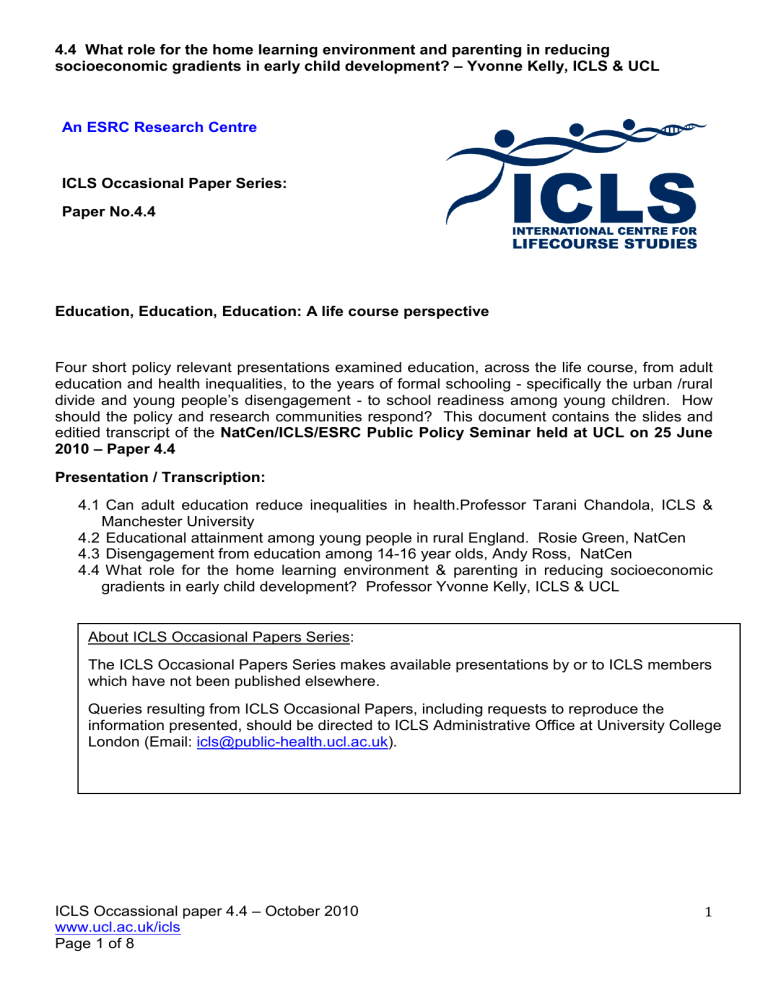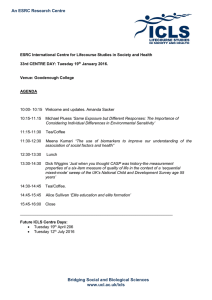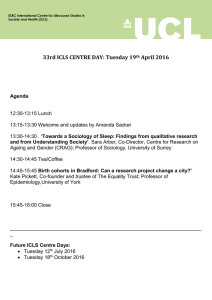4.4 What role for the home learning environment and parenting... socioeconomic gradients in early child development? – Yvonne Kelly, ICLS...

4.4 What role for the home learning environment and parenting in reducing socioeconomic gradients in early child development? – Yvonne Kelly, ICLS & UCL
An ESRC Research Centre
ICLS Occasional Paper Series:
Paper No.4.4
Education, Education, Education: A life course perspective
Four short policy relevant presentations examined education, across the life course, from adult education and health inequalities, to the years of formal schooling - specifically the urban /rural divide and young people’s disengagement - to school readiness among young children. How should the policy and research communities respond? This document contains the slides and editied transcript of the NatCen/ICLS/ESRC Public Policy Seminar held at UCL on 25 June
2010 – Paper 4.4
Presentation / Transcription:
4.1 Can adult education reduce inequalities in health.Professor Tarani Chandola, ICLS &
Manchester University
4.2 Educational attainment among young people in rural England. Rosie Green, NatCen
4.3 Disengagement from education among 14-16 year olds, Andy Ross, NatCen
4.4 What role for the home learning environment & parenting in reducing socioeconomic gradients in early child development? Professor Yvonne Kelly, ICLS & UCL
About ICLS Occasional Papers Series:
The ICLS Occasional Papers Series makes available presentations by or to ICLS members which have not been published elsewhere.
Queries resulting from ICLS Occasional Papers, including requests to reproduce the information presented, should be directed to ICLS Administrative Office at University College
London (Email: icls@public-health.ucl.ac.uk
).
ICLS Occassional paper 4.4 – October 2010 www.ucl.ac.uk/icls
Page 1 of 8
1
4.4 What role for the home learning environment and parenting in reducing socioeconomic gradients in early child development? – Yvonne Kelly, ICLS & UCL
Slide 1
Bridging social and biological sciences www.ucl.ac.uk/icls
Dr Yvonne Kelly, UCL
Slide 2
The influences on child health and development are a vast array of factors influencing foetal growth, the foetal environment, to the general milieu of the home environment and family life, right out to the interactions that children have with people outside of their families, institutions and so on, the neighbourhoods in which we live, and of course the societies in which we live.
An ESRC Research Centre
What role for the home learning environment and parenting in reducing socioeconomic gradients in early child development?
For many years now documented inequalities in markers of child health and development have been discussed in the
Kelly Y, Sacker A, Del Bono E, Francesconi M, Marmot M
2 www.ucl.ac.uk/icls literature. There is quite a large body of work from people like John Ermisch, Jane
Waldfogel, Jean Brooks-Gunn to name but a few. But there are things that we don’t know about the emergence of inequalities in child development. And this paper is focusing on the pre-school years so we are looking at children from ages three and age five and we’re using a contemporary UK data set. And before I say anything else I should thank my co-authors for their contributions to this work. Amanda Sacker, who is sitting here along with Amelia Del Bono,
Marco Francesconi and Michael Marmot. Slide3
An ESRC Research Centre
So as I said it’s been established that there are inequalities and markers of child development. But the exact extent of these inequalities hadn’t been charted in the preschool years in the UK. Neither do we know because the work hadn’t been done before whether inequalities remain constant throughout the pre-school years
ICLS Occassional paper 4.4 – October 2010 www.ucl.ac.uk/icls
Page 2 of 8
Objectives
1. Examine the extent of inequalities in the pre-school years
2. Assess whether inequalities remain constant or widen over time
3. Examine the contribution of the home environment in explaining inequalities
3 www.ucl.ac.uk/icls
2
4.4 What role for the home learning environment and parenting in reducing socioeconomic gradients in early child development? – Yvonne Kelly, ICLS & UCL or whether there are changes. So whether inequalities widen or whether they converge as children enter the school environment, for example.
And the third thing we wanted to do, the third objective was to assess the contribution of aspects of home and family life and the psychosocial environment in the home in terms of helping us to explain any observed inequalities that we’ve seen. Slide 4
The data on the slide show that some details of the data. I am not sure how familiar you are with the Millennium Cohort
Study. It’s a large nationally representative sample of births from the years 2000-2002 in all four countries of the UK, and to date there have been four sweeps of data collection, at age nine months, three, five, and seven years. And this paper takes the data from the first three waves, okay. So at nine months, three and five years. You can see the sample ends on here. Around fifteen thousand children were in the sample at sweeps two and three, at three and five years of age.Slide 5
An ESRC Research Centre
Millennium Cohort Study
Data sweeps: 9 months, 3 and 5 years
Age 3, N=15 382
Age 5, N=15 042
Child development markers
Age 3: Socioemotional difficulties, School readiness, verbal ability
Age 5: Socioemotional difficulties, Verbal ability,
Non-verbal ability, Spatial ability
4 www.ucl.ac.uk/icls
Most of the data of MCS have been collected during home visits. There have
An ESRC Research Centre been administered tests for things like cognitive performance. And much of the data has been collected through self
Family and home environment
• Demographic : mother’s age, household language, whether child was first born completion questionnaires by the parents but there are also some data from routine sources, schools, and of course hospital episode statistics.
• Home learning and family routines : parental basic skills difficulties, frequency of learning activities: anyone at home reads to child, takes child to library, helps with alphabet, writing, reading, numbers/counting, learning songs, poems and rhymes, musical activities, does drawing and painting.
Family routines were whether the child had regular bedtimes and mealtimes.
In this paper we look at two markers of child development. Firstly social emotional development which is assessed using the
Goodman SDQ, the Strengths and
• Psychosocial: maternal psychological distress, parent-child relationship, discipline strategies, parent-child items from the HOME inventory, whether the mother felt she was a competent parent, whether the family had lots of rules and whether these rules were enforced.
5 www.ucl.ac.uk/icls
Difficulties Questionnaire, taps into five domains of child behaviour - hyperactivity, conduct problems, peer problems, emotional symptoms, and pro-social behaviour. Today I will present data on the total score which is a composite of hyperactivity, conduct, emotional and peer problems. And for that we take a binary outcome so we look at the distribution of the scores and we take the top ten per cent because they are most likely to have some sort of clinical relevance or relevance for educational settings.
ICLS Occassional paper 4.4 – October 2010 www.ucl.ac.uk/icls
Page 3 of 8
3
4.4 What role for the home learning environment and parenting in reducing socioeconomic gradients in early child development? – Yvonne Kelly, ICLS & UCL
For cognitive tests in the MCS age three two tests were administered: the Bracken School
Readiness Assessment, I am not showing data from those today. And the British Ability Scales test of verbal ability. At age five three sub-scales from the British Ability Scales on verbal ability, non-verbal ability, and spatial ability were administered but for simplicity today I am just going to stick with the verbal ability scores. So what did we do? We first of all set out to examine the extent of inequality and there should be a slide. Slide 6
So this slide should show the proportion of children with high SDQ scores. So these clinically and educationally relevant social and emotional behaviour scores by family income from richest to poorest, left to right, ages three and five years, three in red and five in blue. As you can see in the most well-off group about 2.4% of children at age three had high scores, upwards to about 16.4% in the lowest income group.
So just under a sevenfold increase. At age five the per cents run from about 2% to just under 16%, so more like an eightfold increase difference. Slide 7
An ESRC Research Centre
14
12
10
8
6
4
2
20
18
16
0
Prevalence of socioemotional difficulties by family income at ages 3 and 5
Richest
Age 3
2
Age 5
3 4
Family income
6
Poorest DK/ refused www.ucl.ac.uk/icls
The next slide shows verbal ability scores.
Again, red for age three and blue for age five. One technical detail – this score, the standardisation sample has a mean score
An ESRC Research Centre
60
Verbal ability test scores by family income of 50 and the score itself has a standard deviation of ten, so a child with a score of
60 is scoring one standard deviation above the mean and a child with a score of 40
58
56
54 one deviation below the mean, just to put these results in context. So at age three you can see there’s about a six point
52
50
48 difference going from left to right, from richest to poorest in verbal ability scores.
Now at age five there’s a nine point
46
Richest 2 3
Family income
7
4 Poorest DK/ refused www.ucl.ac.uk/icls Age 3 Age 5 difference, so going from a mean score of
60 to a score of 51. So when we were thinking about do inequalities remain constant or do they change, thinking about socio-emotional difficulties a sevenfold difference to an eightfold difference. When we tested the relationship statistically there wasn’t a difference. However for verbal ability scores this difference, six points versus nine points, was statistically different. And
I think the key point here is the gap widening at the point of age of entry into school which of course is of huge concern. Slide 8
ICLS Occassional paper 4.4 – October 2010 www.ucl.ac.uk/icls
Page 4 of 8
4
4.4 What role for the home learning environment and parenting in reducing socioeconomic gradients in early child development? – Yvonne Kelly, ICLS & UCL
The next slide shows the distribution of reading to the child. So a number of factors where we hypothesised would mediate this relationship between income and child development. And one of the key factors is reading to the child. Parents were asked how frequently at ages three and five they
An ESRC Research Centre
100%
90%
80%
70%
60%
Age 3 - Someone reads to the child
50% read to the child. This graphs shows the green bars are for daily reading to the child. And at least what parents say they
40%
30%
20% do in the richest group 82% parents said they read to the child on a daily basis. And then there is this massive 28 point
10%
0%
Richest 2
Daily difference, down to 54% of parents in the lowest income group reading to the child on a daily basis. At least that’s what people say they do. Slide 9
3
Family income
Weekly
8
4 Poorest
Less than weekly
DK/ refused www.ucl.ac.uk/icls
And the next slide show is the distribution of a couple of other key markers that would appear to be driving these relationships in our data. On the left hand side for age three and on the right hand side for age five, you can see that the prevalence of parental basic skills difficulties which is the
10 0
9 0
8 0
7 0
6 0
5 0
4 0
3 0
2 0
1 0
0
An ESRC Research Centre
A g e 3 - C h ild h as reg u la r b ed tim es
1 00
90
80
70
60
50
40
30
20
10
0
A ge 5 - C hild h as reg ular b ed t im es
Rich es t 2 3
F a m ily in co me
4 P oores t DK / refus ed
R iches t 2 3 4
F am ily in com e
P oores t D K / refu s ed composite measure of questions about literacy and numeracy asked to both parents, things like can you count change adequately in a shop setting, can you read a child story book to your child, do you have difficulties filling in forms, that sort of thing. So the prevalence if you like of
22
20
18
16
14
12
10
8
6
4
2
0
Age 3 - Parental basic skills difficulties
Richest 2 3
Family income
4 P oorest DK/ refused
9
22
20
18
16
14
12
10
8
6
4
2
0
Richest
Age 5 - Parental basic skills difficulties
2 3 4
Family income
Poorest www.ucl.ac.uk/icls
DK/ refused parents with skills difficulties varies hugely across. 7% in the most well-off group, up to 19% in the lowest income group. And for regular bedtimes, this idea of having routines, family routines, 92% of children in the richest group at age three had regular bedtimes down to about 75% in the lowest income group. Slide 10
ICLS Occassional paper 4.4 – October 2010 www.ucl.ac.uk/icls
Page 5 of 8
5
4.4 What role for the home learning environment and parenting in reducing socioeconomic gradients in early child development? – Yvonne Kelly, ICLS & UCL
The next slide shows how a high score on the SDQ varies by some of these key markers. So, just for example, you can see in the top left that 7% of children whose parents didn’t have skills difficulties have a high SDQ score versus 15% of those who did, so a twofold increase difference. And the top right you can see this relationship by frequency of reading to the child. So 6% of children whose parents said that they’ve read to them on a daily basis versus 24% of those, children whose parents said that they read to them on a less than weekly basis.
5
0
15
10
25
20
An ESRC Research Centre
25
20
15
10
5
0
Age 5 SDQ by parental basic skills dificulties
No Yes
Age 5 SDQ by regular bedtimes
Usually/always Rarely/never
10
15
10
5
0
25
20
25
20
15
10
5
0
A ge 5 SD Q b y som eon e read s to child
Daily Week ly L e ss th an w eek ly
Age 5 SDQ by child helped with writing
Weekly Less than weekly www.ucl.ac.uk/icls
So what’s this showing so far. We’ve got gradients. We’ve got gradients in the exposures, if you like, in terms of our explanatory factors.
And we’ve got gradients in terms of outcomes of interest. Slide 11
In terms of trying to put together the picture trying to explain what’s going on. The next slide shows a table of logistic regression results in which we sequentially adjust for a range of factors. The first column shows the prevalence of high total difficulty score.
So you can see that similar to the slide before, just over 2%, this is at age 3, 2.4% up to 16% in the lowest income group.
Now the second column the figures we adjust for factors which we classified as demographic factors, things like what languages are spoken in the home, the mother’s age, and the number of children and whether the cohort child was the firstborn.
An ESRC Research Centre
Age 3 Socioemotional difficulties
% Model A Model B Model C
Richest
Band 2
Band 3
2.36
3.28
5.85
-
1.30
(0.62 to 2.71)
2.22
(1.08 to 4.57)
-
1.24
(0.59 to 2.59)
1.99
(0.96 to 4.11)
-
1.20
(0.55 to 2.65)
2.06
(0.95 to 4.50)
Band 4
Poorest
11.06
16.41
3.72
4.88
(1.85 to 7.50)
(2.43 to 9.79)
2.98
3.75
(1.48 to 6.03)
(1.87 to 7.54)
2.57
2.81
(1.20 to 5.50)
(1.31 to 6.03)
DK/ refused 9.67
3.39
(1.71 to 6.72) 2.60
(1.31 to 5.15) 2.11
(1.00 to 4.43)
Model A adjusts for: age, gender, mother's age at time of birth, child is firstborn, languages spoken in the home
Model B additionally adjusts for: someone reads stories to the child; someone teaches the child songs, the alphabet, counting; the child does painting activities at home; child is taken to the library; a parent has basic skills difficulties; the child has regular meal and bed times
Model C additionally adjusts for: discipline scale; child-parent relationship (Pianta) scale; Mother's
K6 score; HOME inventory score; Mother's parenting competence; family rules and enforcement of rules
11 www.ucl.ac.uk/icls
The third set of figures you can see we adjust for those factors which we conceptualise as home learning environment and family routines. So activities in the home like reading to the child, telling stories, going to the library, as well as things like regular meal times and bedtimes, and this composite score of parental basic skills difficulties.
And the last column of figures is when we add markers of the psychosocial environment into the mix. So we can try to control for things like the mum’s psychological distress scores, the warmth of the relationship between parent and child, the sorts of things that parents do in terms of disciplining strategies for want of a better phrase. Okay. So there is this sequential adjustment
ICLS Occassional paper 4.4 – October 2010 6 www.ucl.ac.uk/icls
Page 6 of 8
4.4 What role for the home learning environment and parenting in reducing socioeconomic gradients in early child development? – Yvonne Kelly, ICLS & UCL for factors. And as you can see looking at the second column when we adjust for demographic factors in the row, in terms of the poorest income group the fifth row an odds of about 4.8, 4.9
compared to children in the richest group. Remembering that the unadjusted odds were about
7. So quite a portion of the variation there explained by demographic factors. More of the variation is explained when adjustment for home learning and family routines with the odds going down to 3.8, 3.7. And finally, the final model the odds going down to about 2.8. So I think we start off with an odds of around 7 and we get down to an odds of about 2.8. Quite a lot of that variation has been explained by the model. There still remains a gradient, almost threefold increased likelihood of problem behaviours for children in the poorest group compared to those in the richest group. Slide 12
The next slide shows a similar table only these are linear regression results for verbal ability scores at age three. I showed before the patterned distribution of social and emotional difficulties by our explanatory factors. And we see very similar patterns when we look in that bivariate sense at verbal ability scores. So we ran the same models for verbal ability and the first column shows the kind of unadjusted mean scores and then as before adjusted for demographic, home learning and psychosocial factors. And as you can see the coefficients which roughly
An ESRC Research Centre
Age 3 Verbal ability
Richest
Band 2
Band 3
Band 4
Poorest
DK/ refused
Mean
53.93
53.71
52.71
50.00
47.62
50.97
-
Model A
-0.10
(-1.05 to 0.86)
-0.94
(-1.84 to -0.05)
-2.89
(-3.80 to -1.98)
-4.77
(-5.72 to -3.81)
-2.05
(-3.09 to -1.01)
-0.48
(-1.36 to 0.40)
-2.00
(-2.91 to -1.08)
-3.67
(-4.61 to -2.72)
-1.16
(-2.17 to -0.16)
-0.55
(-1.40 to 0.30)
-1.85
(-2.74 to -0.95)
-3.19
(-4.13 to -2.25)
-0.99
(-1.99 to 0.01)
Model A adjusts for: gender, mother's age at time of birth, child is firstborn, languages spoken in the home
Model B additionally adjusts for: someone reads stories to the child; someone teaches the child songs, the alphabet, counting; the child does painting activities at home; child is taken to the library; a parent has basic skills difficulties; the child has regular meal and bed times
Model C additionally adjusts for: discipline scale; child-parent relationship (Pianta) scale; Mother's K6 score; HOME inventory score; Mother's parenting competence; family rules and enforcement of rules
12
-
Model B
0.15
(-0.80 to 1.09)
-
Model C
0.12
(-0.80 to 1.04) www.ucl.ac.uk/icls equate to score differences, mean score differences, are progressively attenuated on adjustment for demographic, home learning environment and psychosocial factors. So starting off at a base of around 6, 6.2 and going, reducing down to about 3.2 So just under half of the variation appears to be explained by the model. I think in proportional terms about 60% of the variation was explained in social and emotional outcomes by the model. And we see very similar patterns when we look at the data for age five but a bit less of the variation seems to be explained by the model, possibly because the child is spending less time in the home setting, so with those transitions into school. Slide 13
So I’ll just summarise these findings: They are obviously of policy relevance and stark inequalities exist. We knew that before we started in a sense but we’ve confirmed that these very strong inequalities exist in these pre-school years. And that they widen in terms of verbal ability scores. So we’ve got this widening, this increased gap. The home learning environment appears to be important as does the psychosocial environment in helping to explain these differences across the income groups. This
ICLS Occassional paper 4.4 – October 2010 www.ucl.ac.uk/icls
Page 7 of 8
An ESRC Research Centre
Summary
• Stark income inequalities in markers of early child development are evident in the UK.
• Results suggest that the income gap widens during the preschool years.
• Statistical adjustment for home learning and family routines and psychosocial factors ‘explain’ about 60% of the income gap in socioemotional difficulties, and up to 50% of the income gap in cognitive test scores.
• Unexplained differences are substantial.
13 www.ucl.ac.uk/icls
7
4.4 What role for the home learning environment and parenting in reducing socioeconomic gradients in early child development? – Yvonne Kelly, ICLS & UCL has several policy implications and of course the choice of policy might depend on the administration. Of some concern is the idea that, you know, we just tell parents that they need to read to their children and get them to bed on time and I’m not sure, I’m sort of slightly sceptical about that particular line, but of course equally sceptical that in the current climate that policies around redistribution of wealth will be taken up. I think I’ll end there. Thank you.
[END OF RECORDING]
ICLS Occassional paper 4.4 – October 2010 www.ucl.ac.uk/icls
Page 8 of 8
8


